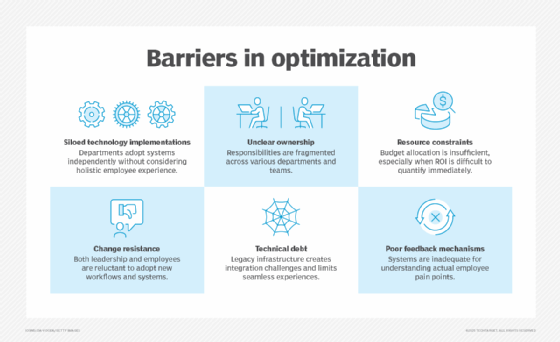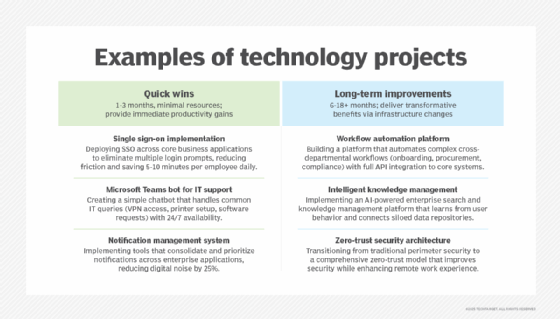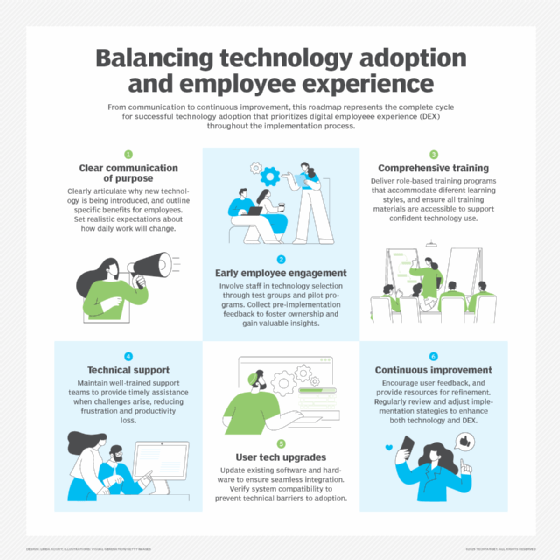
Getty Images
Strategies to boost DEX scores and employee productivity
Poor digital experiences cost organizations talent and productivity. Learn how to measure and boost DEX scores for a thriving digital workplace.
Digital employee experience scores have become a critical metric for businesses navigating the complexities of hybrid work environments. Typically measured on a scale of 0 to 100, these scores gauge how effectively employees interact with their organization's digital ecosystem, from cloud platforms and business applications to internal systems and communication tools.
While DEX scores provide crucial insights into a digital workplace, many companies struggle to collect and interpret the data. Moreover, organizations can face barriers when implementing improvements, including fragmented infrastructure, budget constraints, resistance to change and technical debt.
Despite these challenges, the benefits justify the effort. Higher DEX scores correlate directly with increased productivity, reduced workplace friction and stronger employee retention. Through strategic planning, employee-centric design and continuous optimization, organizations can transform their digital workplace from a source of frustration to a catalyst for success.
This article explores practical methods for improving DEX scores and transforming digital work environments. Using actionable frameworks and examples, examine key success factors, such as self-service capabilities; performance monitoring systems; and strategies for frictionless technology adoption.

6 steps to achieve a higher DEX score
DEX improvements require a systematic approach tailored to each company's unique environment. The following framework provides a structured pathway for developing a successful digital employee experience strategy.
1. Establish a strategic foundation
A strong DEX strategy starts with clearly defined goals and KPIs. Organizations must regularly collect data about their digital workplace systems to achieve these objectives, generating actionable insights that drive performance improvements.
2. Understand user needs
Success depends on understanding where current digital touchpoints create employee friction. This insight comes from comprehensive feedback gathered through surveys, interviews and other channels. Assessments must examine the challenges faced across all work modes -- office-based, hybrid and remote -- to identify specific pain points in each environment.
3. Create a roadmap
A DEX improvement roadmap should balance quick wins with long-term transformational projects. Organizations should rank initiatives based on their potential employee effect, resource requirements and implementation complexity.

4. Ensure a smooth technology transition
The implementation phase focuses on establishing an integrated environment where tools work seamlessly together. This requires enabling single sign-on across platforms, optimizing cross-system data flow and providing accessible technical support.
5. Empower employees
DEX improvement must ultimately empower employees through comprehensive training programs tailored to diverse skill levels and needs. Organizations should streamline onboarding processes and provide role-specific interfaces and tools. Offering continuous learning opportunities ensures staff remain proficient with evolving digital capabilities.
6. Assess results and adjust
The journey to better DEX scores never truly ends. Organizations must regularly monitor metrics, including load times, errors and system saturation, while collecting employee feedback to identify emerging challenges. The ongoing assessment enables strategic adjustments and reveals new enhancement opportunities.
The power of self-service
Self-service options can significantly improve DEX scores when implemented effectively.
Key benefits include the following:
- Increased autonomy. Employees gain direct control over their workplace needs -- e.g., accessing payroll information, managing benefits and handling administrative tasks without traditional waiting periods and bureaucratic delays.
- Time and resource optimization. Employees can resolve IT issues, submit maintenance requests and manage supply needs immediately rather than waiting for help desk responses, which reduces downtime and increases productivity.
- Flexible access. Self-service platforms enhance employee engagement by making resources available across various locations and devices.
- Reclaimed time. Service departments, including HR and accounting, handle fewer routine requests, reducing their administrative burden.
The critical role of performance monitoring in DEX
Performance monitoring provides visibility into digital resource utilization, enabling significant DEX improvements through the following:
- Proactive issue management. Advanced monitoring systems detect potential problems and overutilized resources before they affect employee productivity.
- Strategic decision support. Performance data transforms subjective impressions into measurable insights, enabling decision-makers to evaluate proposed changes based on concrete metrics.
- Intelligent problem resolution. Detailed monitoring logs pinpoint the root cause of outages or service interruptions, enabling technicians to resolve underlying problems instead of managing the symptoms. AI plays a growing role in this area.
- Automated response. Monitoring alerts can automatically trigger remediation actions, maintaining system health at any hour without human intervention.
How to adopt technology without compromising DEX
New technologies and services can erode DEX and productivity when implemented carelessly. To ensure successful adoption, organizations must prioritize their workforce's experience using the following process:
- Clear communication of purpose. Explain why changes are necessary, outline expected benefits and set realistic expectations about effects on daily work.
- Early employee engagement. Involve staff in technology selection through test groups and pilot programs, collecting feedback before full implementation.
- Comprehensive training. Deliver role-specific training that accommodates different learning styles and ensures accessible material for all users.
- Technical support. Maintain well-trained technical support teams dedicated to helping employees navigate the new technology.
- Infrastructure readiness. Update existing software and hardware to ensure system compatibility before deployment.
- Continuous improvement. Establish channels for ongoing user feedback and allocate resources for postdeployment refinements.
Organizations should approach technology adoption as an ongoing process rather than a one-time event, addressing challenges proactively, maintaining consistent support and regularly adjusting implementation strategies based on real-world results.

Developing a strategy for increasing DEX scores
After recognizing the importance of digital employee experience, organizations must take deliberate steps to improve it. An effective DEX strategy focuses on two core objectives: enhancing employee satisfaction with digital tools and increasing workplace productivity.
To achieve these goals, organizations should implement a comprehensive hybrid monitoring system that combines active feedback collection, passive performance tracking and real-time system analytics.
Self-service capabilities form the foundation of successful DEX strategies by providing intuitive knowledge bases and tools that empower users to solve problems independently. When self-service isn't sufficient, a responsive and knowledgeable help desk must be available to address more complex issues.
Like any strategic initiative, DEX optimization requires sustained organizational commitment and thorough implementation to deliver meaningful results.
Damon Garn owns Cogspinner Coaction and provides freelance IT writing and editing services. He has written multiple CompTIA study guides, including the Linux+, Cloud Essentials+ and Server+ guides, and contributes extensively to Informa TechTarget, The New Stack and CompTIA Blogs.






